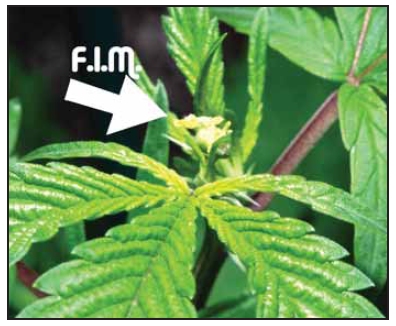 Jef Tek
Jef Tek
TY Cultivation Specialist
I recently conducted an experiment lasting over four separate crops of Afghani Bullrider Sweet 16 that consisted of simply FIM-ing two of the four batches and not FIM-ing the other two. The crops were staggered a week apart and fed the exact same Botanicare nutrients and RO water, each in 4-foot square grow beds and under a 1000-watt HPS light. The acronym “FIM” stands for Fuck, I Missed. When a grower was attempting to top his plants, he inadvertently pinched too little plant material from the top then subsequently coined the term when he found accelerated growth in the remaining branches. FIM-ing is subtler than topping and redistributes hormones throughout the plant without stressing the whole plant too much, as can happen when fully topping them. FIM technically consists of simply trimming or pinching approximately 75% of the top-most growing tip. See picture for better view and you’ll get the idea.
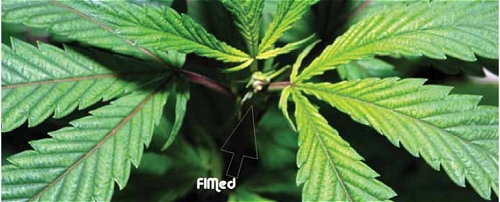
When a plant is intended to be a mother plant, topping is the most popular choice. Topping will produce many, many individual branches that will make dozens of excellent clone-stock. If plants are just too darn tall to fit into the bud room (over 16” tall for an indica or over 12” tall for a sativa indoor crop), then topping is a good choice for you. Obviously, outdoor crop heights don’t matter as much unless you want your outdoor crop to finish below the level of your fence, for example. I discovered topping by accident when I dropped a wall on some plants — one was totally crushed, but one was only decapitated two inches and was left with a hollow stem. I thought it was done-for because of the gaping hole you could slide a pencil into, but in a few days, the remainder of the plant survived and produced just as much buds as the unbroken plants did. It had two main colas the size of my forearm; the rest all had one main cola. Topping works but growth is slightly delayed while the plant recovers, try it — you’ll like it. Dropping a wall on your plants is entirely optional!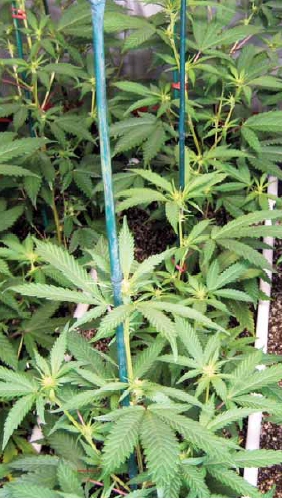
Lollypopping is the technique of trimming-up the lowest branches to give yourself good access for watering and to keep a nice air-gap between the soil and your lowest leaves. These lower branches never get enough light to fully bud and deplete the rest of your plant’s resources if not removed. These lower branches, when removed while still in the vegetative state, make excellent clone donors. They are the oldest part of the plant and have the most hormone buildup and will root quickly. Check them over well and make sure they aren’t infected with thrips or spider mites by giving the fresh cuttings a quick neem oil dip, or H2O2 and water. If every plant lollypopped yields just one clone, you will have a perpetual crop with no need for mothers. This will free up space and prevent bug problems that come whenever anything sits in the same room for more than a month (like mother plants). Lollypopping ultimately gives the remaining buds more girth and fuller “lollypop” appearance when finished flowering. Lollypopping is a must, this you can trust, much better than having your buds in the dust.
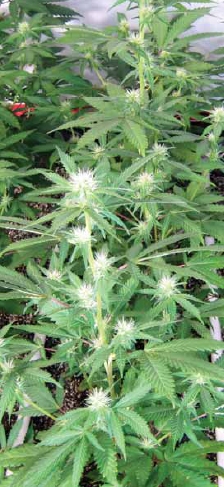
Extreme twisting of plant main stems results in the inner hurd or membrane breaking but without damaging the outer skin. In a week, these twisted areas of the stem will be almost twice as thick and woody. When gently twisted between nodes, you can hear a celery-like snap within the stem; it even works on side branches when they are big enough. These tougher limbs will carry more water and nutrients, which will in-turn create and support heavier buds. This technique is known as supercropping and it too was discovered by accident. When you really want to maximize a crop but are willing to gently “break” each plant and then wait for growth to catch up, this could be just the ticket for you. It is remarkably easy once you get the feel of it. I once had a crop of 32 assorted plants, seven of them were Jack Herrer and in week three of budding, they shot-up nine inches taller than the rest of the room. I didn’t want to just top them nine inches because there were buds already forming on the top colas, but I didn’t want them touching the lights and burning either. My solution was to actually “break” each Jack Herrer plant about 12 inches from the top, then “break” the main stem back up 6 to 8 inches from the first break and tie the two 180-degree bends with a few twist ties. The very next day, the branches that were pointing down in the center section were now facing the light and without careful examination it was hard to even notice. The two 180-degree turns on all seven plants fattened up and delivered all the nutrients necessary to finish the top buds perfectly. The Jack Herrer finished in nine weeks and was the same height as the rest of the room. This is supercropping and it works; that crop will be talked about forever, it was legendary! My four FIM test crops in this story were Lollypopped but not Supercropped.
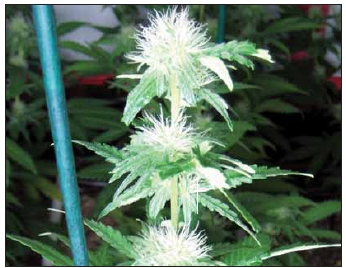
Back to the FIM technique. When you remove the required 60 to 80 per cent of the top sprout, this will cause the rest of the plant’s limbs to firm-up. The top bud will still fill out, but without growing upwards too much. Afghani Bullrider is a mostly-Indica strain that finishes in eight weeks regularly. The FIM-ed crops still finished in eight weeks but some of the main buds were double-wide. You can see some disfiguration of leaves at the FIM level in these photos, but clearly the main bud kept growing. I like the FIM colas because they are flatter and wider, as opposed to the standard pointy colas the non-FIM-ed crop produces. There are still variations from crop to crop because of root development and age of plant when it went into my perpetual bud room, so average weight per plant won’t be a true gauge of performance. My AB plants always average one to two ounces apiece, but the FIM-ed plants are fuller and have more pronounced lateral branches that are fully developed. A theory is if you have the kind of plant that matures from the top down, like Blueberry Skunk does, and you know you can harvest the top cola at eight weeks and the lower buds will keep growing and growing for four or more weeks before finishing, you might try FIM to equalize the harvest time. I like to harvest whole plants and keep the show moving and FIM doesn’t slow anything down. If you pinch off too little there will be no difference whatsoever but when you clip just enough you will wind-up with twin-towering colas on one plant every time, and who out there doesn’t like double colas? I didn’t think so. So the 64 million dollar question, “To FIM or Not to FIM”? The answer is, yes, FIM! You have nothing to lose, they require a little more trimming because they are stockier and bushier, but that trim makes more hash anyway, so why not? FIM stands for “Fuck, I Missed,” but you really can’t miss with this technique. It’s a Win/Win-FIM situation, for sure.
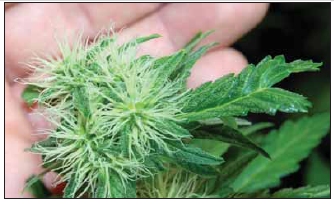
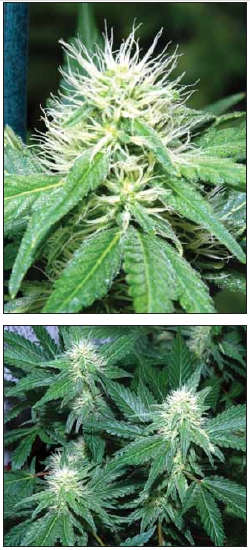
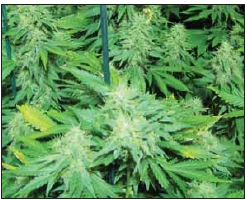
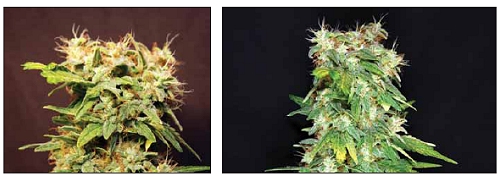

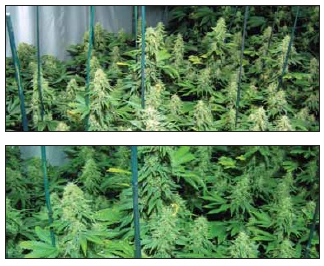




 Contains Introduction Letter, Rate Card & Insertion Order Form
Contains Introduction Letter, Rate Card & Insertion Order Form
I recently came across your blog and have been reading along. I thought I would leave my first comment. I dont know what to say except that I have enjoyed reading. Nice blog. I will keep visiting this blog very often. http://transcendmemorycards.net
I am definitely bookmarking this page and sharing it with my friends.